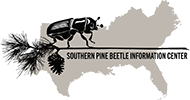Abstract
The southern pine bark beetle guild (SPBG) is arguably the most destructive group of forest insects in the southeastern USA. This guild contains five species of bark beetles (Coleoptera: Curculionidae: Scolytinae): Dendroctonus frontalis, Dendroctonus terebrans, Ips avulsus, Ips calligraphus, and Ips grandicollis. A diverse community of illicit receivers is attracted to pheromones emitted by the
SPBG, including the woodborers Monochamus carolinensis and Monochamus titillator (Coleoptera: Cerambycidae). These woodborers have been traditionally classified as resource competitors; however, laboratory assays suggest that larval M. carolinensis may be facultative intraguild predators of SPBG larvae. This study used polymerase chain reaction (PCR)-based molecular gut content analyses to characterize subcortical interactions between M. titillator and members of the SPBG. The half-lives of SPBG DNA were estimated in the laboratory prior to examining these interactions in the field. A total of 271 field-collected M.
titillator larvae were analyzed and 26 (9.6 %) tested positive for DNA of members of the SPBG. Of these larvae, 25 (96.2 %) tested positive for I. grandicollis and one (3.8 %) for I. calligraphus. Failure to detect D. terebrans and D. frontalis was likely due to their absence in the field. I. avulsus was present, but primers developed using adult tissues failed to amplify larval tissue. Results from this study support the hypothesis that larval Monochamus spp. are facultative intraguild predators of bark beetle larvae. Additionally,
this study demonstrates the capabilities of PCR in elucidating the interactions of cryptic forest insects and provides a tool to better understand mechanisms driving southern pine beetle guild population fluctuations.
To read the full article please visit the link below:
Schoeller, Erich N., Claudia Husseneder, and Jeremy D. Allison. 2012. “Molecular Evidence of Facultative Intraguild Predation by Monochamus Titillator Larvae (Coleoptera: Cerambycidae) on Members of the Southern Pine Beetle Guild.” Naturwissenschaften 99 (11): 913–24. https://doi.org/10.1007/s00114-012-0973-6.
